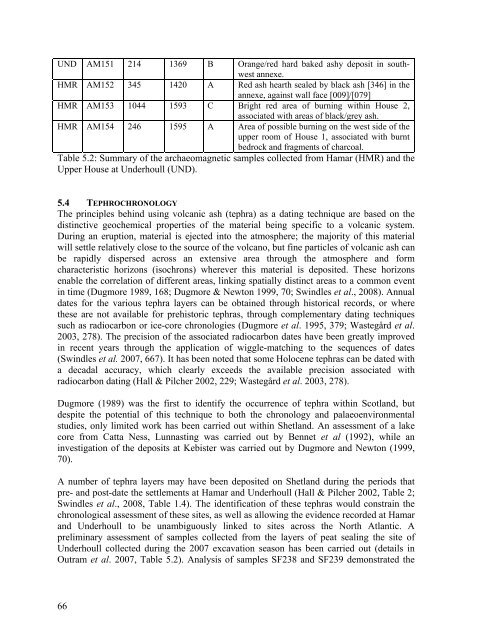VIKING UNST PROJECT: FIELD SEASON 2008 - Nabo
VIKING UNST PROJECT: FIELD SEASON 2008 - Nabo
VIKING UNST PROJECT: FIELD SEASON 2008 - Nabo
- No tags were found...
Create successful ePaper yourself
Turn your PDF publications into a flip-book with our unique Google optimized e-Paper software.
UND AM151 214 1369 B Orange/red hard baked ashy deposit in southwestannexe.HMR AM152 345 1420 A Red ash hearth sealed by black ash [346] in theannexe, against wall face [009]/[079]HMR AM153 1044 1593 C Bright red area of burning within House 2,associated with areas of black/grey ash.HMR AM154 246 1595 A Area of possible burning on the west side of theupper room of House 1, associated with burntbedrock and fragments of charcoal.Table 5.2: Summary of the archaeomagnetic samples collected from Hamar (HMR) and theUpper House at Underhoull (UND).5.4 TEPHROCHRONOLOGYThe principles behind using volcanic ash (tephra) as a dating technique are based on thedistinctive geochemical properties of the material being specific to a volcanic system.During an eruption, material is ejected into the atmosphere; the majority of this materialwill settle relatively close to the source of the volcano, but fine particles of volcanic ash canbe rapidly dispersed across an extensive area through the atmosphere and formcharacteristic horizons (isochrons) wherever this material is deposited. These horizonsenable the correlation of different areas, linking spatially distinct areas to a common eventin time (Dugmore 1989, 168; Dugmore & Newton 1999, 70; Swindles et al., <strong>2008</strong>). Annualdates for the various tephra layers can be obtained through historical records, or wherethese are not available for prehistoric tephras, through complementary dating techniquessuch as radiocarbon or ice-core chronologies (Dugmore et al. 1995, 379; Wastegård et al.2003, 278). The precision of the associated radiocarbon dates have been greatly improvedin recent years through the application of wiggle-matching to the sequences of dates(Swindles et al. 2007, 667). It has been noted that some Holocene tephras can be dated witha decadal accuracy, which clearly exceeds the available precision associated withradiocarbon dating (Hall & Pilcher 2002, 229; Wastegård et al. 2003, 278).Dugmore (1989) was the first to identify the occurrence of tephra within Scotland, butdespite the potential of this technique to both the chronology and palaeoenvironmentalstudies, only limited work has been carried out within Shetland. An assessment of a lakecore from Catta Ness, Lunnasting was carried out by Bennet et al (1992), while aninvestigation of the deposits at Kebister was carried out by Dugmore and Newton (1999,70).A number of tephra layers may have been deposited on Shetland during the periods thatpre- and post-date the settlements at Hamar and Underhoull (Hall & Pilcher 2002, Table 2;Swindles et al., <strong>2008</strong>, Table 1.4). The identification of these tephras would constrain thechronological assessment of these sites, as well as allowing the evidence recorded at Hamarand Underhoull to be unambiguously linked to sites across the North Atlantic. Apreliminary assessment of samples collected from the layers of peat sealing the site ofUnderhoull collected during the 2007 excavation season has been carried out (details inOutram et al. 2007, Table 5.2). Analysis of samples SF238 and SF239 demonstrated the66
















